Capturing your audience’s attention for even five minutes is a huge accomplishment for brands in today’s competitive content marketing landscape.
On the other hand, movies and TV shows can capture the attention of those same people for hours and make it difficult to walk away from (we even have a term for this: bing watching). So what’s the difference?
Storytelling.
If your brand can create an effective narrative, you’ll be able to capture your audience’s attention for longer periods of time, make a more memorable impression, and improve brand loyalty.
Here are nine excellent examples of storytelling marketing to inspire your content.
What Is Storytelling in Marketing?
What do stories have to do with marketing?
Since people remember stories 22x more than facts and figures, storytelling in your content can boost conversion rates.
A story is an “account of imaginary or real people and events told for entertainment,” so storytelling is simply the art of sharing a message in the form of a story. For businesses, a story is a powerful medium to convey their message in a gripping and memorable way.
So what separates a powerful story that sells your brand from a mediocre story that will be soon forgotten?
First, it should have a relatable character. This character could be a real person (such as an influencer, founder or brand evangelist) or a fictional character created by the brand that serves as an example. We use made-up characters in our post on marketing funnels for this very purpose:
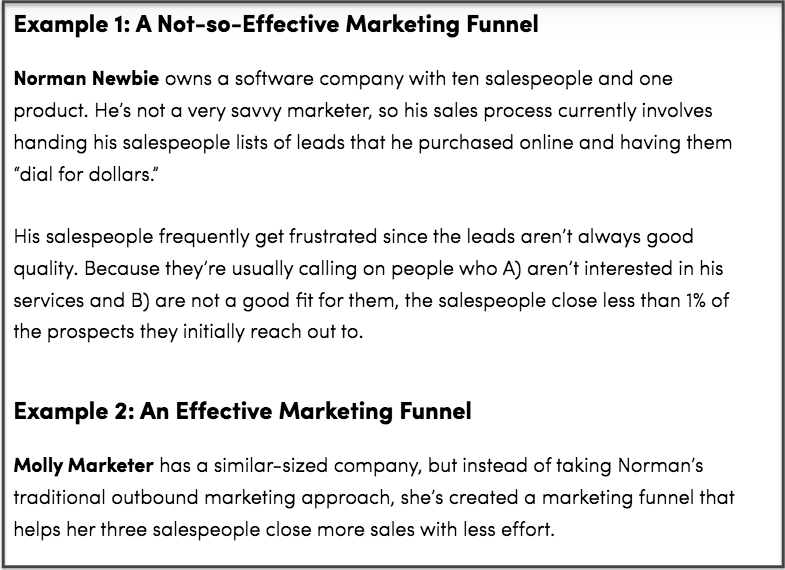
In addition, there should be some sort of conflict that this person faces, a learning process, and a satisfying resolution.
If you include these elements, you’re already off to a great start. Remember, the most compelling stories are those that are the most relatable or touching to the target audience’s heart.
Before we dive into some excellent examples of the power of storytelling in action, let’s first mention the key elements of good storytelling.
5 Principles of Good Storytelling
If you want to transform your ordinary product into something extraordinary, you need to market your services with impressive storytelling. And in order to implement storytelling in your content marketing strategy, you need to understand the principles of storytelling.
Here are the 5 basic principles of storytelling that every business should follow:
1) Choose a Relatable Main Character
A story is incomplete without a main character. The protagonist, or hero, adds a face to the story to which people can relate. As mentioned above, this can be a real person or brand, or a fictional one.
Either way, you need to choose a character that makes it easy for audiences to understand your story and you need to make him or her attractive (not as in “good looking”; as in “appealing”). This character should be interesting and well-defined enough to leave an impression in the minds of the reader.
2) Put the Best Elements in the Beginning of Your Story
Just as with an article with a great hook, you should put the best elements of your story at the beginning rather than saving “the best” for the end. You want to immediately lure the reader or watcher into your story and compel them to share your blog or video with others.
For example, instead of using a title like How I Became An Entrepreneur that doesn’t connect with the audience, use a title like How I Started Earning $100,000 Per Year from My Mom’s Basement. The second title is much better because here you have put the best element of your story – the juicy detail: money – at the beginning.
Related Content: How to Write Hero Headlines to Skyrocket Click-Through Rates
3) Create “Conflict”
It might sound strange but, yes, conflict in your story helps keep your audience engaged. Now, how do you create conflict in your brand’s story without getting your CFO arrested for bank robbery?
Four steps to creating (and overcoming) conflict:
- First, you need to make your customers or niche influencers the hero of your story and when we first see them, they have an issue or a problem that they want to solve, or a desire or action they want to achieve. This is most people before they discover a helpful product.
- At the beginning, they must fail (or already have failed) with whatever they are trying to achieve. If they immediately get what they want, yay for them, but then there’s no story.
- Then, add differing opinions and obstacles to create conflict that gets in the way of the hero achieving their goal. This could be the research stage of a consumer trying to find a solution to their problem.
- Finally, when the protagonist finds your product or service, the obstacles are overcome and they achieve their desire and/or fix their problem. Things should fall into place only at the end.
4) Understand the Relationship Between Listening and Telling
There is a reciprocal relationship between listening to and telling stories. Just imagine that you are telling a story to a group of people, but they aren’t listening to you. Will you be able to tell your story? Nope.
Identify the obstacles to getting your audience to listen to you, such as:
- External obstacles
- Physical obstacles
- Internal obstacles
- Psychological obstacles
- Relational obstacles
In the case of marketing, getting your audience to listen to your story means understanding their mental state, their likes and dislikes, their attention span, their behavior, etc. Otherwise, all your efforts are wasted.
Related Content: The Ultimate Guide to Developing Buyer Personas (with Templates!)
5) Keep Your Story Authentic
People love authenticity, which is the fastest way to connect with another human being. It is up to you to produce a story that is genuine and unique. Do not steal other people’s ideas or try to come across as someone you are not just to impress them.
As long as you stay true to your brand, it will be easy for people to react (and connect) to your story. In other words, your brand personality should be reflected in your story, so if you are a rule-bending startup, create a funny or irreverent narrative. If you are a traditional law firm, create a reassuring and professional narrative.
People buy products after reading the stories associated with those products, so what is more authentic than this?
Related Content: The Art of UX Storytelling: How to Create Your Brand’s Story
9 Brilliant Examples of How Brands Use Storytelling in Marketing
Here are nine storytelling marketing examples to provide inspiration on how you can use effective stories across your marketing strategy. These examples cover multiple marketing channels (not just TV and YouTube ads), as well as cover B2B and B2C brands.
1) New York Presbyterian Hospital: Connect with Your Audience Through Your Customers
New York Presbyterian Hospital has one of the most active social media accounts across the healthcare sector. And after scrolling through just a few of their posts, it’s easy to see why their audience is so captivated by their brand.
Rather than proving their expertise and skill by showing off complex healthcare information, they accomplish the exact same mission through simple patient stories.
For example, this video and social media post is about a singer that suffered a heart attack:
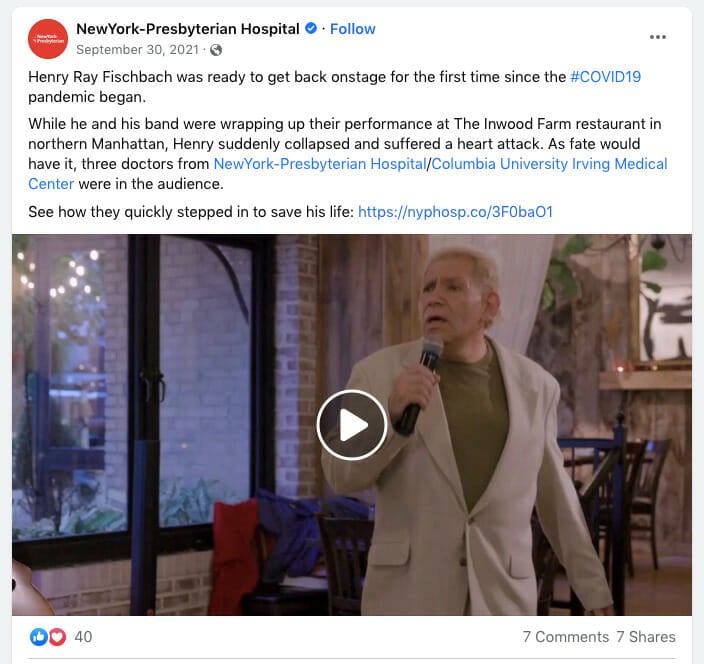
As you can see, the conflict of the story is that the singer/patient had a heart attack, and the doctors were there to save the day (the heroines of the story). It has a happy resolution and, on the whole, is the kind of story you would see in a movie.
Therefore, it’s no surprise that this story performs well. There are plenty of other patient stories as well, like this one of seventh grader Ashley Santa Anna:
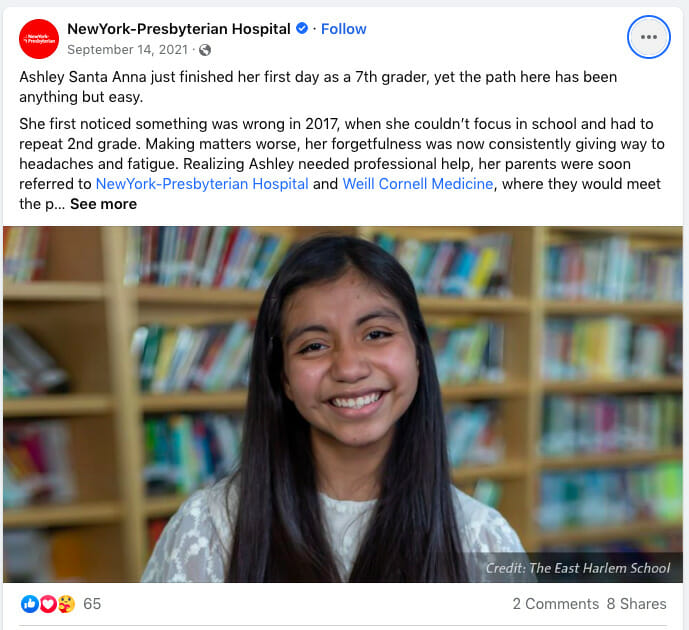
Key Takeaway: Rather than writing dry case studies about your successes, ask your customers to share their stories and the challenges they faced before using your brand.
2) Justin Goff: Connecting with Your Audience Through Pain Points
When we think of storytelling, it often includes images, videos or spoken word, though it’s an essential element of copywriting as well.
Virtually any professional copywriter can provide case studies of how storytelling has helped them scale their offers and sell more, and Justin Goff is no exception.
Originally one of the most in demand copywriters for his uncanny ability to produce multi-million successes over and over again, he now has a mastermind for up-and-coming copywriters. To sell seats to this mastermind, he uses storytelling in virtually every email. Here’s just one email that he sent out advertising the mastermind:
Last November, Michael Rochin was unexpectedly fired from his job as a customer service rep. So his $55,000 income disappeared in an instant. And with a wife and a 2-year old daughter relying on him, Michael felt like he was letting them down.
“It was a pretty dark time for me. I was the sole provider and I was failing. I couldn’t even afford Christmas gifts for my daughter”
Michael was in a bad place…. But he knew that he needed to make money. So he was applying for ANY job possible.
Things like customer support…. And doing deliveries for Door Dash…. But he wasn’t getting hired. He kept getting denied. So he cut his expenses to the bone, and lived off his small savings for the next few months.
That was until February came around and we had our Copy Accelerator event in Las Vegas.
I remember Michael posting in our Justin & Stefan Talk Copy group and mentioning that he wanted to come to the event, but he didn’t have the money. He said he was determined to do anything and everything possible to get the money to go.
His wife thought he was nuts. “You’re not spending $3,000 to go to an event,” she said.
But after a few weeks of pleading with her…Michael finally convinced his wife that this would be the best thing for their family. So he ponied up the little money that he had for a ticket, and went to the event in Vegas.
However, once he was at the event in Vegas his imposter syndrome flared up so bad that he almost left.
“I tried to leave on the first day before the event even started. I felt like I didn’t belong in that room,” he said.
Luckily Stefan found Michael trying to slink out of the room, and pulled him back in. And over the next 2 days Michael’s eyes were opened to what was possible as a copywriter.
He connected with other writers that were making money he never thought possible. Copywriters pulling in $20k and $30k a month….
He met business owners like VShred, Natural Health Sherpa, Cody Bramlett and 4Patriots who he talked to about writing copy for them.
“It changed everything for me,” he said.
Now what’s even crazier is that as eye opening as the event was for Michael…on the second day of the event, Stefan pulled me aside and said Michael wanted to sign up for our mastermind.
I was surprised. “Wait, you mean the guy who could barely afford to be here? How’s he gonna do that?”
It seemed like quite a stretch for me. But Stefan knew Michael better than I did. And told me that his copy skills were actually pretty solid already.
“I think if we can get him a few clients in the first month he’s going to do really well,” Stefan said.
I was skeptical. Mostly because I don’t like putting someone who is down to their last penny into a $3k a month coaching program. But Stefan was adamant that it was the right thing for him.
So I said “ok.”
That was back in the beginning of March that all this went down. And in the two months since joining the mastermind, Michael has picked up numerous high paying copywriting jobs. He has a monthly retainer client in the health niche. As well as multiple clients that he’s working with on a per-project basis.
In fact, last month was his best month ever as copywriter – bringing in $10,000! Which is an amazing feat in that short of a time frame. Especially considering where he was just a few months prior to this.
Michael’s a great testament to the idea that the best things come out of your darkest times. So a big congrats to Michael on his success so far. And for being our Copy Accelerator member of the week.
Both Stefan and I are excited to see you continue to grow this year.
If you want to hear more of Michael’s story, and the big things he’s learned in Copy Accelerator, feel free to watch the interview I just did with him. It’s posted on YouTube right here.
As you can see, despite being a long email, it’s a gripping tale for anyone who is interested in becoming a copywriter or is struggling to earn more as a copywriter.
However, Justin also sends plenty of emails that only include small anecdotes to prove his point. The reason why I suspect his emails perform particularly well is that the character in the story is always someone real. For B2B, this is powerful.
For example, most of the anecdotes in his emails are about his own trials and challenges in the early days of his copywriting career and how he managed to overcome them.
Even if you sell a B2B product, consider how you can add stories to your brand’s narrative. People like interacting with other people, so make your brand human.
Key Takeaway: Most people think of TV commercials and viral social media posts for B2C brands when they think of storytelling in marketing. However, there are plenty of opportunities for B2B brands to incorporate storytelling into their written content as well. Just practice writing stories and learn how to create tension and resolve it.
Related Content: 15 Tips and Tricks to Write Better B2B SaaS Website Copy
3) Nike: Allow Your Brand’s Influencers to Tell the Story for You
Nike is known for having remarkably strong marketing collateral. Each message is powerful and stands behind the core values of Nike – which is interesting given that the founder, Phil Knight, revealed in his book Shoe Dog that he didn’t believe much in marketing in the early days of the business.
However, perhaps it was because they didn’t believe in marketing that they did so well. Rather than forcing the product on people with flashy branding, they went out to their customers, created a better product, and asked athletes with large followings to use their product. The brand became synonymous with strength, grit and hard work.
Even today, Nike athletes such as LeBron James and Michael Jordan are known for not only their talent on the field/court, but also their core values of hard work and determination.
The company’s strong storytelling messaging is apparent in virtually every advertisement they make. For example, this video features not one hero, but a group of heroes (the minority community) overcoming their sports goals as well as the challenges of racial differences and discrimination:
Your hero doesn’t have to be a single person. It can be a group of people fighting and struggling towards the same goal.
Key Takeaway: Consider using influencers who support your core values and have them tell your brand’s story for you.
Related Content: Just Do It: What We Can Learn from Nike’s $39B Marketing Strategy
4) Noah Kagan: Share Your Own Raw Stories to Connect
Noah Kagan is the founder of AppSumo, a company that sells software and now drives nearly $100 million per month. However, he also is working towards building his personal brand and has created a YouTube channel that is an excellent example of storytelling marketing in the B2B sector.
Each video is informative and instructive, and the content pulls from his own personal experiences. These personal experiences are excellent examples of storytelling. For instance, in this video, he tells the very real and raw story of how he was fired at Facebook:
This kind of experience is unique and yet relatable for anyone struggling with their current job. It also brings hope to those watching as Noah proves that you can go on to create a multi-million-dollar company even if you are living your worst moment.
You might be thinking that you don’t have any stories as interesting as getting fired from one of the largest companies in the world. Fortunately, your stories don’t have to too impressive or wild. Most of Noah’s stories are about things he did when he was younger to get going – various side hustles, networking events, and other perfectly attainable goals.
Key Takeaways: If you’re struggling to create a storyline, just look at your team. Leverage their experiences to create a relatable story for your next marketing campaign.
5) Kerrygold: Create Fictional Stories to Connect
If you’re selling a B2C brand, a popular way to connect with the audience is through fictional storytelling. These stories can be sweet, funny or humorous, as long as they portray a captivating narrative.
Kerrygold is an excellent example of this.
Their ad “First Day“ is about a family that wakes up early to prepare a special meal for the son that has just completed his first day on the job (presumably as a chef):
While it may seem impossible to create a story around butter, it’s more about how Kerrygold butter is a part of the family’s lives. Without this butter to connect them, they wouldn’t have the perfect dish share with the son and, therefore, the perfect surprise.
The ad was created in mid 2020 and they are still running it at the end of 2023, so it’s safe to assume that this is one of their most successful ads.
Key Takeaways: If you have what you think is a rather mundane product, focus on the lives of your customers and create fictional stories that are emotionally charged. In this case, rather than focusing on butter (“how do you tell an emotional story about churned cream??”), it focuses on the experience that butter helps create for Kerrygold customers.
6) Patagonia: Using Your Customers’ Stories
Patagonia is another excellent example of a brand that has risen to the top of a very competitive industry thanks to its storytelling marketing strategy.
Instead of creating fictional stories, as Kerrygold did, they tell the real stories of their customers’ lives in the outdoors. However, rather than just running story-based marketing campaigns on one channel, it’s the common denominator across every single marketing campaign they run.
For example, their social media accounts post videos of their customers’ stories:
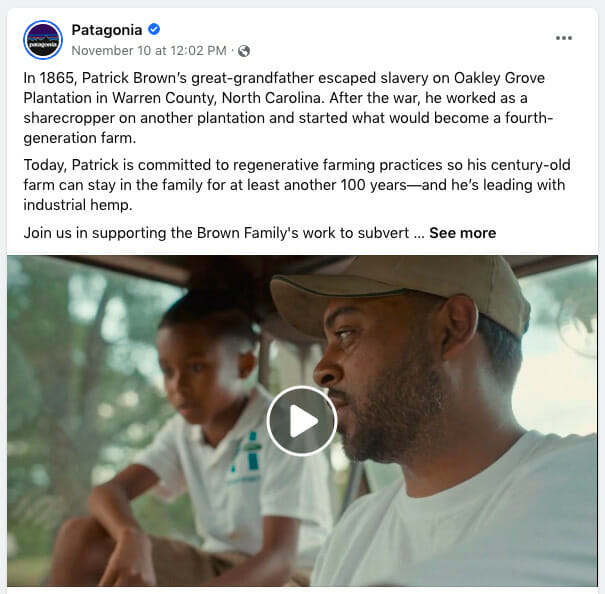
While the blog offers written customer stories:
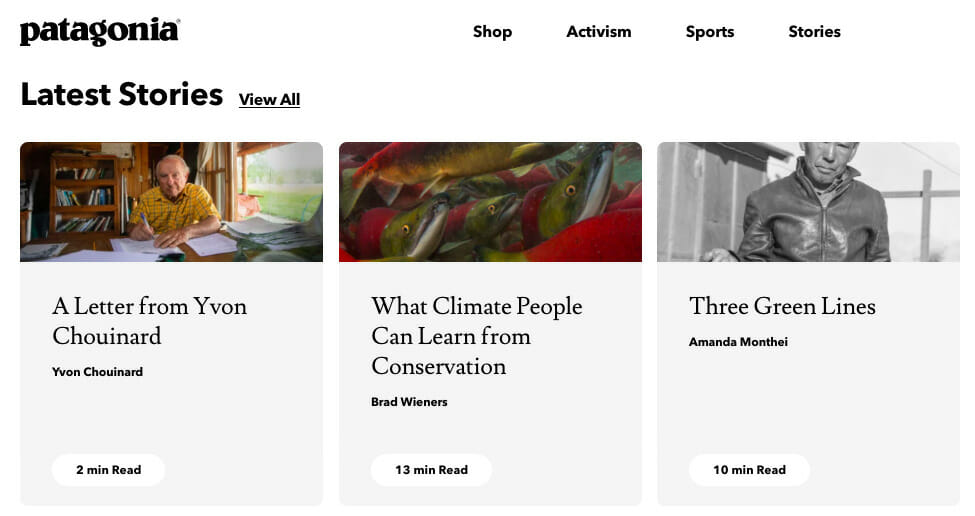
Key Takeaways: As you incorporate storytelling into your marketing, use an omnichannel approach where every piece of content produced is underlined with a story – not just a single channel. In addition, using your customers as the characters of your story is the best way to relate to potential customers.
Related Content: 5 Tips to Build a Seamless Omnichannel Customer Experience
7) IKEA: Use Humor to Promote Your Products and Services
IKEA Singapore uses humor and hilarious puns in their storytelling videos to illustrate practical storage and furniture solutions.
This video is entitled Improve Your Private Life and is narrated by Fille Güte, a “Shelf-Help Guru”. It features a typical husband and wife arguing about the lack of space in their bedroom – and then the Shelf-Help Guru comes in with a solution: IKEA’s Pax wardrobe, Malm drawers, Komplement interior fittings, etc.:
The video uses humor to great effect:
- Wife: “I just wish you knew what to do with your junk.”
- Husband looks mortified. Camera pans down to his hips, then refocuses on the pile of junk on the floor of their small bedroom.
- Cut to Shelf-Help Guru suggesting IKEA furniture to solve the problem of space in their bedroom and, at the same time, saving their marriage.
The ad ends by saying “Begin your journey of shelf discovery”. This story is something that every couple faces at some point in their relationship, and IKEA hits all the right points. It’s a common story with a unique touch! You can even see in the video comments below how much people love IKEA’s humorous ads.
Key Takeaway: Don’t be afraid to get personal with your customers. Be funny but stick to your brand values at the same time. Use an influencer to convey your message and offer a solution to the problem.
8) Dove: Share Stories About Real People to Stir Up Emotions
Dove is one of the first brands that popularized the idea of featuring their customers in their videos. Mostly they’ve featured women, but recently the company made a shift and featured men (dads) in their videos. The concept was amazing.
In their video Dove® Men+Care® Mission: Care, they show a man named John reuniting with his family on Father’s Day outside his U.S. military base after talking about how hard it is to be away from his kids for months at a time.
This video is a true story created with the Operation Homefront to let military personnel reunite with their families on special occasions – and I dare you to watch it without tearing up!
Key Takeaway: Focus on real people and use authentic emotions in your story. Your brand motto must match the story moral presented in the video. In the case of Dove, it was “we care for you”.
9) Huggies: Use Data to Create a Touching Story
Global diaper brand Huggies leveraged the power of hugs to win moms emotionally.
At one time, Pampers had 100% of Canadian hospital contracts for supplying diapers. Huggies had to increase their market share, so in order to defeat Pampers, they created and promoted a campaign named “No Baby Unhugged”.
Their campaign was based on research that proved hugs help stabilize babies’ vital signs, ward off illness and promote brain development. Their video features a mom and her newborn baby in the hospital. Mom is seen hugging her baby along with this caption: “Hugs strengthen your baby’s immune system, they promote weight gain and improve brain development.”
It promoted the use of Huggies diapers in hospitals and pressed on the message that Huggies is the best gift a mother can give her baby.
The result of the campaign was amazing with sales of Huggies Newborn Diapers increasing by 30%.
Key Takeaway: Educate people about your product by creating a story that features your product’s USP (Unique Selling Point). Use data and research to back up your suggestions and leverage the power of story and emotions to persuade people that your product is best.
Final Thoughts
Brand storytelling is the key to leaving a lasting impression on your audience. A good story can captivate a listener in ways that no facts or data ever could.
Reassess your current marketing strategy and ask yourself where you could incorporate more stories into each campaign. If you need inspiration, just turn to your team or customers for entertaining stories.
Or, if you want someone with years of experience telling stories, contact the Single Grain team today. We can help you tell your brand’s story in a more compelling manner and deliver the desired message to your audience.



